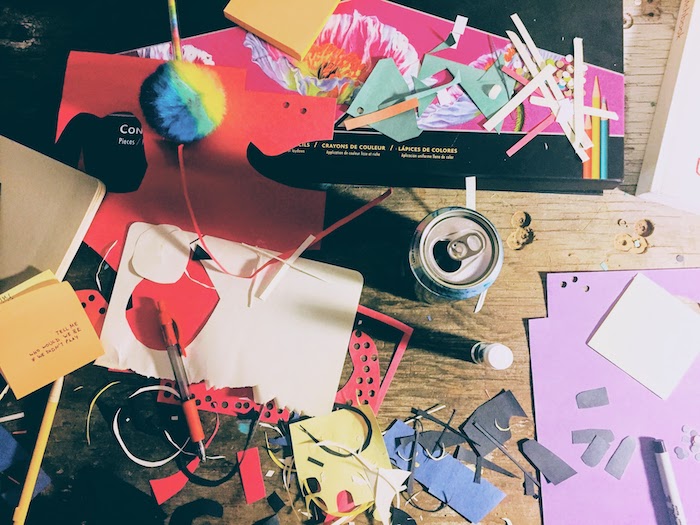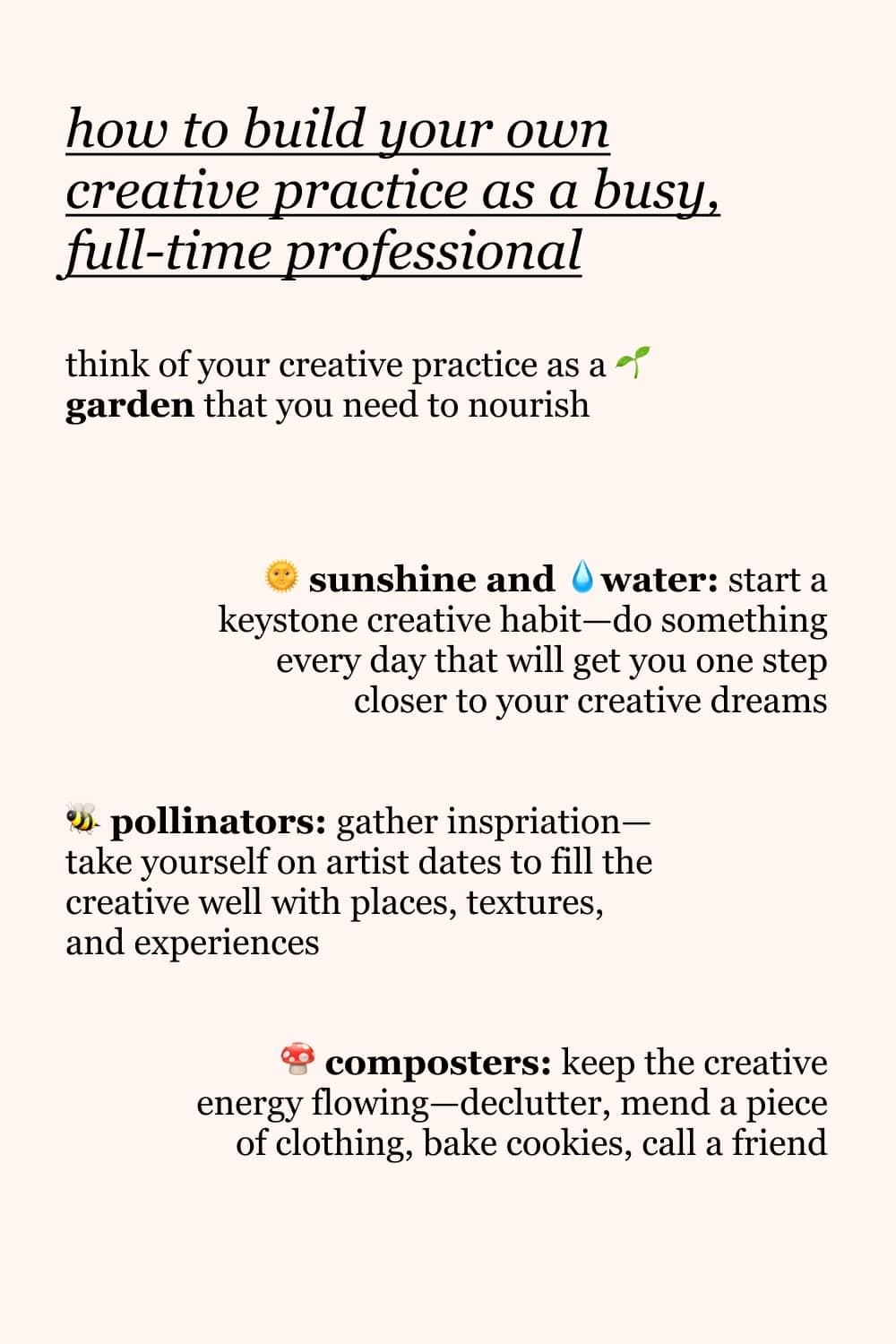Centered and spacious: How to build your own creative practice as a busy, full-time professional
As someone who works a nine-to-five job, I know how it feels to try and hold it all together outside work. Cooking, cleaning, and social obligations quickly add up to a full schedule that often feels overwhelming or downright monotonous.
But I promise it doesn’t have to be this way.
By building your own creative practice, you can make small changes in your routine that will bring more inspiration, joy, and meaning to your day-to-day — even if you work full-time!

What is a creative practice? #
Anything you do on a regular basis that exercises your creative muscles and connects you with spiritual, creative energy & flow. Yes, I said spiritual. This is a spiritual practice. It is one part showing up to do the work and one part trusting that the universe will take care of the rest.
Here are some components of my personal creative practice:
- Writing these blog posts & newsletters
- Painting
- Journaling
- Walking
- Pole dancing classes
- Cutting out magazine clippings
- Feeding quarters into toy vending machines
- Reading books about birds and permaculture
- Decluttering
In this article you’ll learn about how to build your own creative practice by growing and nurturing the three components of your Creative Practice Garden.
The three elements of your Creative Practice Garden #
- Sunshine and water (the keystone habit of your creative practice): This is the foundation of your creative practice, the habit that grounds you and sustains you creatively. For me, it’s walking to a coffee shop every day at 3:30 PM, opening my notebook or laptop and writing.
- The pollinators (activities you do to spark inspiration): These are the inspiration-gathering activities that nurture your inner artist. Going for a nature walk or visiting an art supply store fit into the category of creative pollinator.
- The composters (low energy creative activities): Activities for keeping your hands busy when your creative energy is low. Such as baking or mending.
Now, let’s dig deeper into the first element of the Creative Practice Garden, the sunshine and water.
Work through this article with a free Notion template. #
Sunshine and water: The keystone habit of your creative practice #
Plants simply cannot grow without sunshine and water, and you cannot have a creative practice without a keystone creative habit.
James Clear, author of Atomic Habits describes keystone habits as the routines that lead to a cascade of other actions.
Clear uses exercise as an example of a keystone habit that naturally put the rest of his life in place:
When I worked out, I wanted to eat better. Even though I could have rewarded myself with chocolate bars and ice cream, I felt like eating real, healthy foods.
I also slept better. And when I was awake, I seemed more productive. Especially in the hour or two after working out, when my mind seemed to think clearer and my writing was crisper. Thoughts flowed easily.
When I didn't exercise, however, I was more prone to eating junk food. I would stay up later working on unimportant tasks. I started to feel tension in my back. I didn't check it, but my guess is that my blood pressure raised as a result of additional stress and no place to release it.
In other words, fitness is the keystone habit the puts the rest of my life in place. When I workout, other things naturally fall into place. I don't have to think about eating better. I don't have to force myself to focus on getting things done. Exercise naturally pushes me towards my best self.
In the book The Artist’s Way, author Julia Cameron suggests that the foundational centering activity for every creative person is Morning Pages.
Morning Pages are three pages of longhand, stream of consciousness writing, done first thing in the morning. There is no wrong way to do Morning Pages–they are not high art. They are not even “writing.” They are about anything and everything that crosses your mind– and they are for your eyes only. Morning Pages provoke, clarify, comfort, cajole, prioritize and synchronize the day at hand. Do not over-think Morning Pages: just put three pages of anything on the page...and then do three more pages tomorrow.
When you are active in this part of our creative practice, you are centered, grounded, and working toward the creative life of your dreams.
This part of your creative practice usually requires the most creative energy, so it is important to prioritize it and make sure it happens every day, or at least several times a week. In order to make it happen, you’ll likely need to turn it into a ritual.
Twyla Tharp, dancer and choreographer, writes about the importance of ritual in her book The Creative Habit. For Tharp, the most important ritual is waking up in the morning and hailing a taxi to the gym.
I begin each day of my life with a ritual: I wake up at 5:30 A.M., put on my workout clothes, my leg warmers, my sweatshirts, and my hat. I walk outside my Manhattan home, hail a taxi, and tell the driver to take me to the Pumping Iron gym at 91st Street and First Avenue, where I work out for two hours. The ritual is not the stretching and weight training I put my body through each morning at the gym; the ritual is the cab. The moment I tell the driver where to go I have completed the ritual.
It’s not at all glamorous. In fact, it’s quite ordinary, and that’s what makes it magical. Anyone can establish a ritual that becomes the keystone habit in their creative practice.
Tharp concludes:
It's vital to establish some rituals—automatic but decisive patterns of behavior—at the beginning of the creative process, when you are most at peril of turning back, chickening out, giving up, or going the wrong way.
Don't take your creative keystone habit too seriously #
One thing to remember is to not put too much pressure on yourself to make something great, or even good, during this part of your practice.
When you write, don’t say “I’m going to write a poem.” That attitude will freeze you right away. Sit down with the least expectation of yourself; say “I am free to write the worst junk in the world.” You have to give yourself the space to write a lot without a destination. I’ve had students who said they decided they were going to write the great American novel and haven’t written a line since. If every time you sat down, you expected something great, writing would always be a great disappointment. Plus that expectation would also keep you from writing.
— Natalie Goldberg, Writing Down the Bones: Freeing the Writer Within
How to figure out when your creative energy is at its peak #
Write down the last time you felt like you were in a “flow state” while working on something. Use the Notion template to work through these prompts.
In positive psychology, a flow state, also known colloquially as being in the zone, is the mental state in which a person performing an activity is fully immersed in a feeling of energized focus, full involvement, and enjoyment in the process of the activity.
For me, the flow state is when I am completely immersed in my creative practice and lose track of time.
Now, write down as much detail about that time as you possibly can. What were you wearing? How much did you sleep the night before? What time of day was it? Were you at home or somewhere else?
If you’re unsure, take note of your natural rhythms over the next few weeks. These are the clues for creating your own keystone creative habit.
The pollinators: For when you need inspiration #
The second element of your creative practice is for collecting inspiration and filling your creative well with interesting places, textures, and images.
In The Artist’s Way, the pollinating activity for artists is called an Artist Date.
The Artist Date is a once-weekly, festive, solo expedition to explore something that interests you. The Artist Date need not be overtly “artistic” — think mischief more than mastery. Artist Dates fire up the imagination. They spark whimsy. They encourage play. Since art is about the play of ideas, they feed our creative work by replenishing our inner well of images and inspiration. When choosing an Artist Date, it is good to ask yourself, “what sounds fun?” — and then allow yourself to try it.
Here’s a short list of some pollinating activities:
- Go for a nature walk and look for birds
- Go to the library and spend an hour immersed in a new topic
- Go to a thrift store. Give yourself $5 to spend and find something really great that you can do something creative with.
- Take yourself out for dinner and a movie
- Try a new dance or exercise class
- Fly a kite
- Go fishing
- Make yourself tea using your nicest dishes
- Walk around a cemetery
- Watch a documentary about one of your favorite artists
- Go to a garage sale or an estate sale
- Play on the swing set at a park
- Go to a free museum
- Visit a plant nursery
The composters: Keep the creative energy flowing #
Our bodies are garbage heaps: we collect experience, and from the decomposition of the thrown-out eggshells, spinach leaves, coffee grinds and old steak bones of our minds come nitrogen, heat and very fertile soil. Out of this fertile soil bloom our poems and stories.
— Natalie Goldberg, Writing Down the Bones: Freeing the Writer Within
I find that certain daily activities encourage the decomposition of ideas. I use my “composting” activities to replace “bad habits,” which for me includes watching eight hours of TV on Sunday evenings while simultaneously switching between scrolling Instagram and Twitter.
How about instead of watching Netflix for eight hours or scrolling Twitter, I try that new cinnamon roll recipe? Baking is one of my favorite low-energy creative activities that I call a composter, an essential component of a healthy Creative Practice Garden.
Low-energy composting activities keep the creatieve energy flowing. And as a person who works full-time, I often find myself doing these creative composting activities at the end of a long day. These activities keep me from becoming blocked or sucked in by social media.
When it comes to low-energy activities, multitasking is encouraged. Listening to an hour-long podcast while doing something with your hands can be the perfect form of creative composting.
Here’s a list of composting activities to add to your Creative Practice Garden:
- Clipping images out of magazines
- Mending clothes
- Embroidery, knitting, crocheting
- Baking or cooking (pies and soups are always good options)
- Gardening
- Decluttering & rearranging your workspace
- Deep cleaning something in your space
Build your own Creative Practice Garden #
Your creative practice is unique to you. Have fun experimenting with the three components until you've laid the foundation for your own healthy and nourished Creative Practice Garden.
Download and use this free worksheet and get started immediately! To start using this Notion template, go to the top right hand corner and click Duplicate to add the page to your Workspace and edit it there.

Subscribe to Soft Practice—An email newsletter for artists and makers
Soft Practice is about making art without an art degree, paying attention, and keeping the promises we make to ourselves. It's about practice. And quitting. And starting again.
It arrives in your inbox once a month (usually on a Sunday) and is best consumed with a hot beverage. In each newsletter I will share all the messy parts along my journey to becoming a full-time artist and maker, help you get organized to better manage your creative projects, and offer up some thoughtful (and sometimes weird) recommendations.
